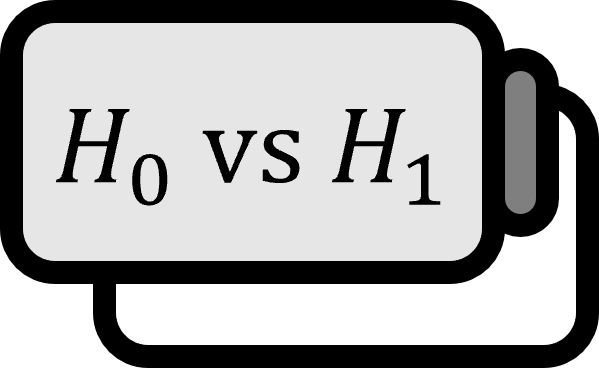Simplified Definition of Hypothesis Testing
Definition 1 2
In science, a statistical hypothesis refers to an assumption about a population, and the statistical decision-making process of accepting or rejecting this hypothesis is called statistical hypothesis testing. This process involves two competing hypotheses, where the hypothesis that the researcher wishes to support is called the alternative hypothesis $H_{1}$, and the hypothesis accepted when there is no substantial evidence to claim that the alternative hypothesis is true is called the null hypothesis $H_{0}$. The statistic used for hypothesis testing is called the test statistic.
Explanation
If you major in statistics, you’ll find yourself in a never-ending battle: null hypothesis $H_{0}$ vs alternative hypothesis $H_{1}$… It may seem very difficult at first, but as you get to know it, you will find both annoyance and fondness, so don’t be too scared to learn about it.
Let’s put aside the complex mathematical concepts found in textbooks (like critical region, test statistic, significance level, etc.) for a moment and imagine how hypothesis testing can emerge in everyday situations. Consider the scenario where a hypothetical pharmaceutical company A releases a new drug, a, that assists liver function, specifically by lowering one of the liver enzyme levels, AST:
- For a to be commercialized, it must pass certain tests by regulatory authorities, such as the Food and Drug Administration, which obviously means proving that a lowers the AST levels. Naturally, this proof shouldn’t be as simplistic as ‘just bring in more than 10 people whose AST levels have dropped’ but should make statistical sense.
- What about having more than 10 out of 100, or ‘more than 10% of all clinical trial participants’ show reduced levels? This seems more rational than the previous notion, but one could still wonder if lowering AST from 500 to 490, even with 11-40 people, should be considered an effect.
- One method could be to divide into two groups: one that continuously takes drug a $1$ and another placebo group $2$, then compare the average results of their liver enzyme levels. Let’s say the average for the $1$ group is denoted as $\mu_{1}$, and the average for the $2$ group is denoted as $\mu_{2}$. The desired outcome for pharmaceutical company A might look something like this. $$ \mu_{1} < \mu_{2} $$ According to the definitions mentioned above, the alternative hypothesis can be established as follows. $$ H_{1}: \mu_{1} < \mu_{2} $$
- Just looking at the formula, comparing the levels of 500 and 490 might still seem problematic. However, now we’re talking about statistics of a sample population, not just one or two individuals. For instance, even if it’s 500 vs 490, if the variance is 200, it could just be a fluke. But if the variance is around 2, then drug a seems to definitely lower AST levels. [ NOTE: The idea of using the variance of two groups to compare their means seems quite useful. This concept has been developed into what’s known as Analysis of Variance. ]
- But for now, let’s return to hypothesis testing. If the alternative hypothesis is established as shown above, the null hypothesis can be the following opposite content.
$$
H_{0}: \mu_{1} \ge \mu_{2}
$$
It’s important to note that the condition for accepting the null hypothesis is ’there is no substantial evidence that the alternative hypothesis is true’, not that the null hypothesis itself is being actively adopted. Acceptance of the null hypothesis comes from the inability to reject it, not because it has been proven to be true.
- For example, if explorer Columbus’s alternative hypothesis was ’there exists the continent of America’, failing to find America on his first voyage doesn’t make the null hypothesis ’the continent of America does not exist’ true. It’s accepted for the time being because there’s no firm evidence yet, indicating that the absence of evidence is not evidence of absence.
- Fortunately, let’s say the alternative hypothesis $H_{1}$ is proven to be true statistically. Strictly speaking, however, what this analysis reveals is only that the group taking drug a has reduced AST levels. Analysts, who may not have as much expertise in the domain as clinicians or pathologists, can confidently say, ‘for some reason, the effect of the drug is definitely proven’, but this doesn’t serve as evidence for causality as to how drug a lowers AST levels.
See Also
- A simple definition of hypothesis testing: Introduces a definition that’s easier to understand rather than being strictly rigorous.
- How to set null and alternative hypotheses: Explains possible issues with that definition.
- A complex definition of hypothesis testing: Introduces a relatively strict mathematical definition of hypothesis testing.
